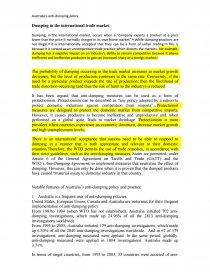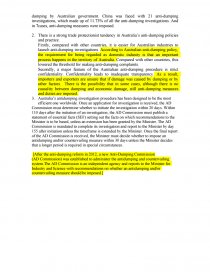Australia'a Anti-Dumping Policy
Essay by lyuyannan • May 18, 2016 • Essay • 801 Words (4 Pages) • 1,375 Views
Australia’s anti-dumping policy
Dumping in the international trade market
Dumping, in the international market, occurs when a “company exports a product at a price lower than the price it normally charges in its own home market”.[8] While dumping practices are not illegal,[9] it is internationally accepted that they can be a form of unfair trading.[10] This is because it is viewed as an uncompetitive trade practice which distorts the markets. For example, dumping has a negative impact on an industry’s ability to remain competitive because it allows inefficient and ineffective producers to gain an increased share of a foreign market.[
The probability of dumping occurring in the trade market increases as market growth decreases, but the level of production continues at the same rate. Conversely, if the need for a particular product exceeds the rate of production, then the likelihood of trade distortion occurring (and thus the risk of harm to the industry) is reduced.
It has been argued that anti-dumping measures can be used as a form of protectionism. Protectionism can be described as “any policy adopted by a nation to protect domestic industries against competition from imports”.[19] Protectionist measures are designed to protect the domestic market from competitive imports. However, it causes producers to become ineffective and unproductive and, when performed on a global scale, leads to market shrinkage. Protectionism is more prevalent when countries experience an economic downturn, decrease market growth and high unemployment levels.[
There is an international acceptance that nations need to be able to respond to dumping in a manner that is both appropriate and relevant to their domestic situation] Therefore, the WTO permits the use of trade remedies, in accordance with their strict guidelines, such as the anti-dumping measures. ]States are permitted, under Article 6 of the General Agreement on Tariffs and Trade (GATT) and the WTO’s Anti-Dumping Agreement, to implement measures that neutralise the effect of dumping. However, this can only be done when it is proven that the dumped products have caused “material injury to domestic industry in that country.
Notable features of Australia’s anti-dumping policy and practice
- Australia is a frequent user of anti-dumping policies.
United States, European Union, Canada and Australia are notorious for their frequent implementation of anti-dumping policy.
From 1981to 1994 (when WTO has not established), Australia initiated 702 anti-dumping investigations, which made up 24.96% of all the 2813 anti-dumping investigations worldwide.
From 1995 to 2005, Australia initiated 179 anti-dumping investigations, which made up 6.30% of all the 2840 anti-dumping investigations worldwide. And in 67 of 179 investigations, anti-dumping measured were applied. In the same period, globally, anti-dumping measured were applied in 1804 investigations. Australia made up 3.71%.
...
...

